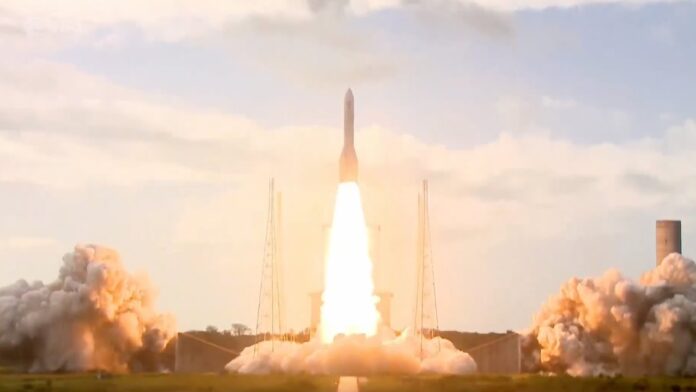Europe’s Ariane-6 rocket completes maiden flight, faces technical setback during critical mission phase
In a landmark event for European space endeavours, the Ariane-6 rocket lifted off from its launchpad in French Guiana amidst cheers and anticipation from ground crews and space enthusiasts alike. The €4 billion heavy-lift rocket, developed to bolster Europe’s independent access to space, embarked on its inaugural mission aimed at deploying a cluster of satellites into orbit.
The launch, scheduled for 16:00 local time (19:00 GMT), proceeded smoothly as Ariane-6 ascended to its designated altitude and successfully released several small satellites into space. However, excitement turned to concern during the final stages of the mission when the rocket’s upper stage encountered an unexpected anomaly. Computers onboard autonomously shut down the auxiliary power unit (APU), a crucial component responsible for pressurizing the propulsion system. This malfunction prevented the upper stage from executing its planned burn to exit orbit and deploy two re-entry capsules as part of the mission’s concluding tasks.
Despite this setback, officials from the European Space Agency (ESA) and ArianeGroup, the rocket’s manufacturer, declared the mission a success. Josef Aschbacher, ESA’s director general, expressed relief and excitement over the achievement, emphasizing the historical significance of successfully launching a new heavy-lift rocket. He noted that such events are rare, occurring only once every few decades, highlighting the technological prowess and determination behind Ariane-6’s development.
Ariane-6, designed as a successor to the Ariane-5 model, shares a familiar external appearance but integrates advanced manufacturing techniques such as 3D printing and augmented reality design. These innovations are expected to streamline production processes and potentially reduce costs, enhancing its competitiveness in the global launch market. The rocket operates in two configurations: “62” with two solid-fuel side boosters for medium payloads and “64” with four strap-on boosters for heavier satellites.
The anomaly during the inaugural flight, particularly the failure to demonstrate the upper stage’s re-ignition capability, poses a technical challenge for future missions. Martin Sion, CEO of ArianeGroup, assured readiness to address such issues promptly, underscoring plans for subsequent launches later this year and throughout the coming years to validate and improve Ariane-6’s performance.
Analysis:
Political:
Politically, Ariane-6’s successful launch underscores Europe’s commitment to maintaining sovereignty in space exploration and satellite deployment. It signals Europe’s capability to compete with other global players, albeit facing challenges from more cost-effective, reusable rocket technologies pioneered by American companies like SpaceX.
Social:
Socially, Ariane-6’s development and launch reflect broader societal aspirations for technological advancement and exploration beyond Earth’s atmosphere. It inspires a sense of collective achievement and national pride, highlighting Europe’s role in pushing the boundaries of space exploration.
Economic:
Economically, Ariane-6’s ability to attract commercial contracts, including those from major satellite operators like Jeff Bezos’ Kuiper constellation, is crucial. The rocket’s performance and reliability will determine its market competitiveness and potential profitability for European space industries and stakeholders.
Environmental:
Environmentally, the use of expendable rockets like Ariane-6 contrasts with the trend towards reusable rocket technology aimed at reducing space debris and launch costs. The balance between technological advancement and environmental sustainability remains a critical consideration for future space missions.
Technological:
Technologically, Ariane-6’s integration of advanced manufacturing techniques positions it as a modern launcher capable of adapting to diverse mission requirements. Continued innovation in rocket design and propulsion systems will be essential for maintaining its relevance and competitiveness in the evolving space industry.
